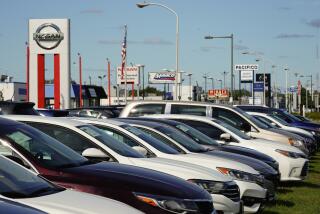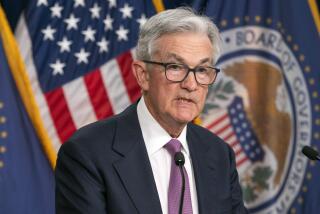Two Banks Stun Markets by Hiking Prime to 7.75%
- Share via
NEW YORK — Citibank stunned the financial markets Tuesday by raising its prime lending rate to 7.75% from 7.5%, a move that marks the first reversal of the downward trend in the closely watched interest rate in nearly three years and signals a possible rise in consumer borrowing rates.
The surprise move by the nation’s largest bank, which was quickly followed by Chase Manhattan Bank, also may portend another hazardous day on the stock market today because investors link higher interest rates to inflation and slower economic growth.
“This is really a shocker,” Lawrence Wachtel, a market strategist for Prudential-Bache Securities Inc., said of Citibank’s move. “Given that the (stock) market is still in very tenuous psychological shape after Monday, I think the market’s going to take it on the chin.”
Citibank’s news came minutes after the stock market had closed for the day after recovering some ground from a huge loss on Monday. The Dow Jones industrial average of 30 blue-chip stocks rose 26.28 points to 2,304.69 Tuesday after succumbing the day before to a 57.39-point loss, its third-worst performance for a single day ever.
But word that the prime lending rate charged by a major financial institution had budged for the first time since it fell from 8% to 7.5% seven months ago sent bonds lower and the dollar higher in currency trading in New York. The benchmark 30-year bond, which was ahead of Monday’s close by 0.375 of one point, reversed course and quickly moved down 0.125 of one point after the news.
Futures markets also were hit sharply by the news, with stock index futures “sagging badly on the news,” observed Newton Zinder, chief market analyst with E. F. Hutton.
Both Citibank and Chase Manhattan said they were motivated by the level of prevailing money market rates, which have been edging upward in recent days. A spokesman for Citibank noted particularly that the prime rate has been lower than money market rates in London, where banks are active in the Eurobond market.
The banks’ cost of funds--the amount they have to pay depositors and institutions they themselves borrow from--has been inching up slowly over the last few weeks. But analysts and economists said the prime rate increase also is further fallout from the recent collapse of the dollar, itself the victim of the Reagan Administration’s move last week to impose trade sanctions on Japan for the first time since World War II.
Hard to Attract Interest
“The dollar had a lot to do with it,” observed Ben Niedermeyer, president of Janus Value Fund, a Denver investment management and mutual fund firm. “It is much harder to attract interest from foreign investors when your currency is being debased, so you have to raise interest rates.”
After dropping to a new low against the yen in Tokyo on Monday and continuing its fall there Tuesday, the dollar rose Tuesday against the yen and most other major currencies on the New York currency market. The higher prime rate was one reason.
Within a half-hour of Citibank’s announcement, the dollar moved from 1.8090 West German marks to 1.8145 marks, a substantial gain over such a short period. And, after having fallen to its third consecutive record low of 145.85 Japanese yen, the dollar jumped back to 146.45 yen.
Although a one-quarter-point increase in the prime is meager, the move is still significant. Not since the prime began its long decline from 13% on June 25, 1984, has there been an increase in this key lending rate, which financial institutions traditionally have charged their best customers and which is considered a benchmark for other interest rates.
The prime has been lodged at 7.5% since Aug. 26, 1986, when Citibank and other major financial institutions lowered it from 8%.
Caught Off Guard
Economists and analysts were caught off guard by news of a higher prime rate and many were scrambling in search of numbers that might justify the banks’ step. “If anything, I thought it might go down, not up,” said James P. Hanbury, an analyst at Wertheim & Co.
With the recent steep descent of the dollar’s relative value, many credit market analysts have been predicting that the Federal Reserve Board will have to drive interest rates higher in order to prop up the dollar in foreign exchange.
But the prime rate was not regarded as a candidate for an increase because market rates have been generally flat for several months, said Security Pacific Bank economist Lee Ohanian.
Changes Infrequently
“The prime changes so infrequently that usually you don’t see a move by the prime unless these market rates have been moving significantly in one direction or the other over a fairly long period and this is a clear trend,” Ohanian said. “Here it looks like they’ve reacted after just two or three days” of increases.
Other economists reacted similarly until they double-checked some numbers after Citibank’s announcement.
“I was surprised, but I should not have been,” said Allen Sinai, chief economist for the Shearson Lehman Bros. brokerage, after finding that the spread between what banks pay for their funds and what they charge borrowers has narrowed sharply in recent weeks from about 1.5 percentage points to less than a point.
Full Impact to Come
The full impact of Tuesday’s increase in the prime rate will not be known until other financial institutions decide whether to follow the lead of Citibank and Chase Manhattan.
“My own feeling is that not everyone is going to jump on this bandwagon,” Wertheim’s Hanbury said. “But even if this is not the start of a trend, it is still not welcome news.”
Sinai predicted that, if the higher rate is widely adopted, “consumers and businesses both will pay more for money and that goes for mortgages too.”
In the past, the prime did not have much direct effect on consumer rates, but that has changed in recent years.
More to Read
Inside the business of entertainment
The Wide Shot brings you news, analysis and insights on everything from streaming wars to production — and what it all means for the future.
You may occasionally receive promotional content from the Los Angeles Times.










